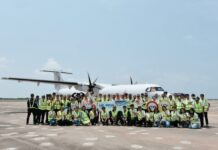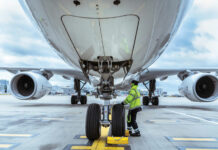

South African Airways (SAA) says it made, “substantial progress,” during the first quarter of 2015 after the successful implementation of a 90 day action plan designed to reduce its operating losses.
The airline posted a net loss of $200 million in its last financial year, up from $91 million in 2013. A sustained currency decline of the rand against the US dollar all but wiped out any advantage to the carrier of lower oil prices in the global markets. According to the company’s latest annual report, total fuel costs actually increased by 16 per cent as a result of the weaker rand despite an average three per cent decrease in the average price of Brent crude oil.
Since 2011, the real rand cost of fuel to SAA has increased 77 per cent, which wasn’t helped after the company also suffered a $15 million loss from fuel hedging after oil prices went down instead of up as it had anticipated. “SAA continues to drive implementation of its long term turnaround strategy across the business,” says SAA. “Commercially the airline has adjusted capacity against declining demand and aggregate load factors of 81 per cent marked the first quarter of the 2015 to 2016 financial year.”
SAA says the business has reduced operating costs by 14 per cent and has made significant strides toward business stability during implementation of its action plan earlier this year. This was plan followed by the positive first quarter of its long term turnaround strategy’s implementation.
In a review of the first few months of its new financial year, which started 1 April 2015, SAA says it realised positive year on year gains in almost all of the market segments in which it is active. However, domestic market conditions remain tricky. Against generally weak demand there was a seven per cent growth in available capacity across the domestic market compared to overall growth of just over two per cent. This is indicating an oversupply of around five per cent.
In June, SAA saw a 14 per cent reduction in operating costs compared to the same period last year and unit costs were seven per cent lower than a year ago and 10 per cent below budget, in part driven by lower oil prices.
Africa remains SAA’s strongest performing business segment with all routes trending upward, despite some segments impacted by the Ebola disease outbreak in late 2014 and early this year. Its airfreight division, SAA Cargo, uses bellyhold space and operates four Boeing 737-300 Freighters. SAA Cargo moves general cargo, perishables, courier, express and mail globally, as well as transporting livestock, dangerous goods, and vulnerable and valuable cargo as part of its special services, along with an ad hoc charter service for more urgent deliveries.
The national carrier, SAA, is represented in 12 countries across the Asia Pacific with direct passenger flights to Hong Kong and Perth, the rest of the region serviced through interline agreements with other carriers.
Regionally, SAA Cargo leverages the passenger network in accessing markets such as Lagos, Accra, Lusaka, Entebbe (Uganda), Kinshasa, Harare, Luanda, Maputo and Nairobi.
In Europe, the markets include Germany, Italy, France, Switzerland, UK, Ireland, Spain, Eastern Europe and Nordic countries, while the North and South American markets include Argentina, Brazil, Mexico and the US.
The airline strengthened its presence in West Africa at the start of the month after the launch of its inaugural flight between Accra, Ghana, and Washington DC (US) in North America. It also introduced a Johannesburg (South Africa)to Abu Dhabi service in March.













